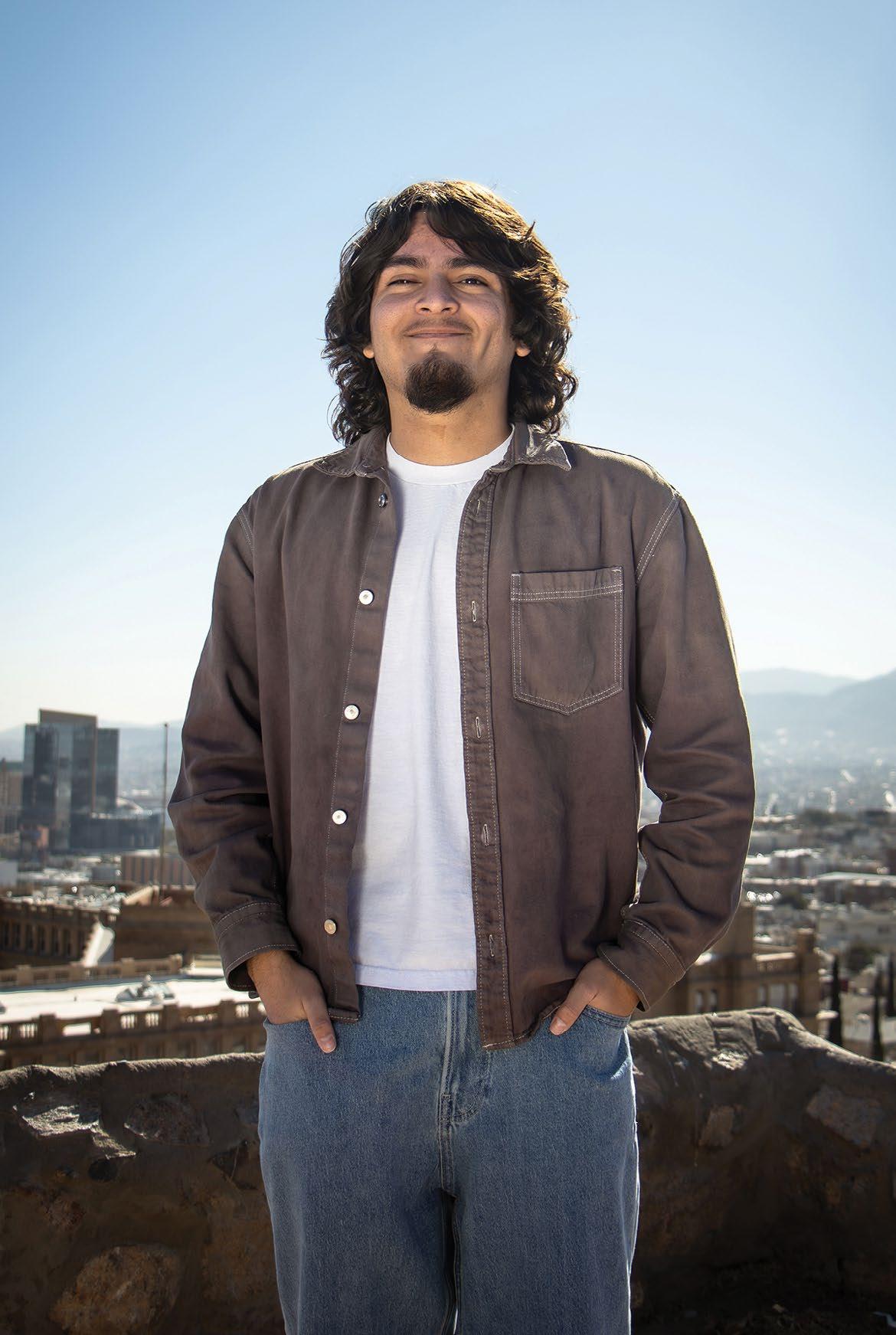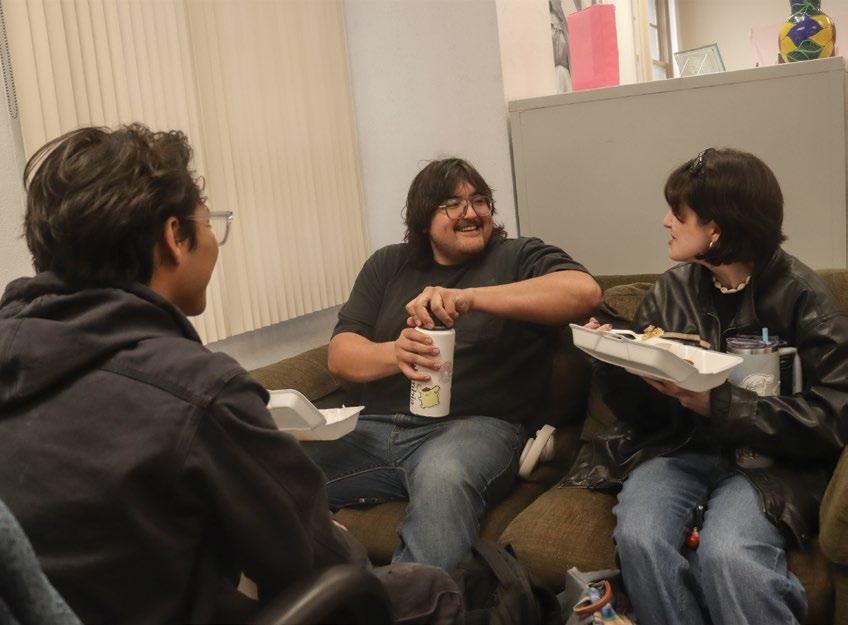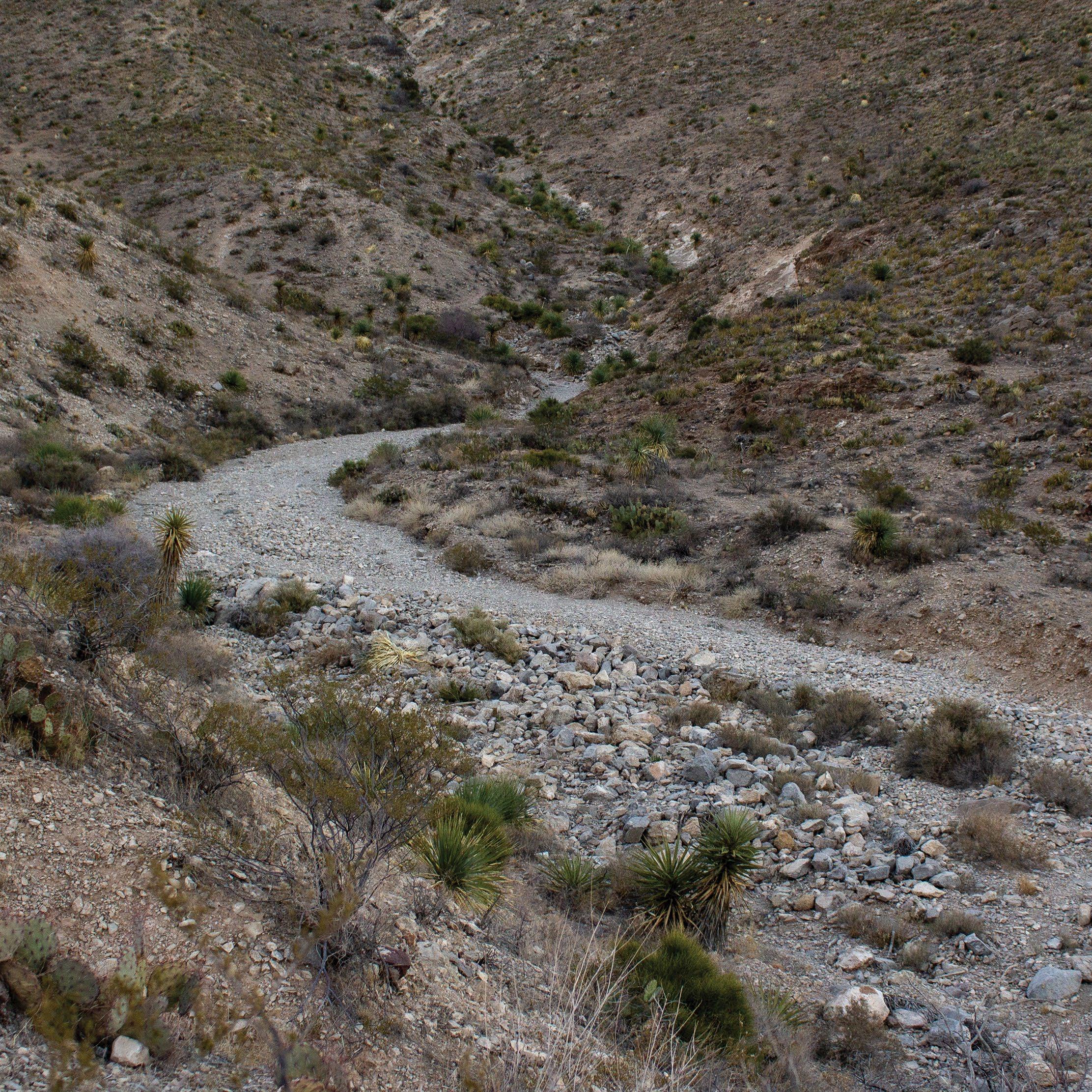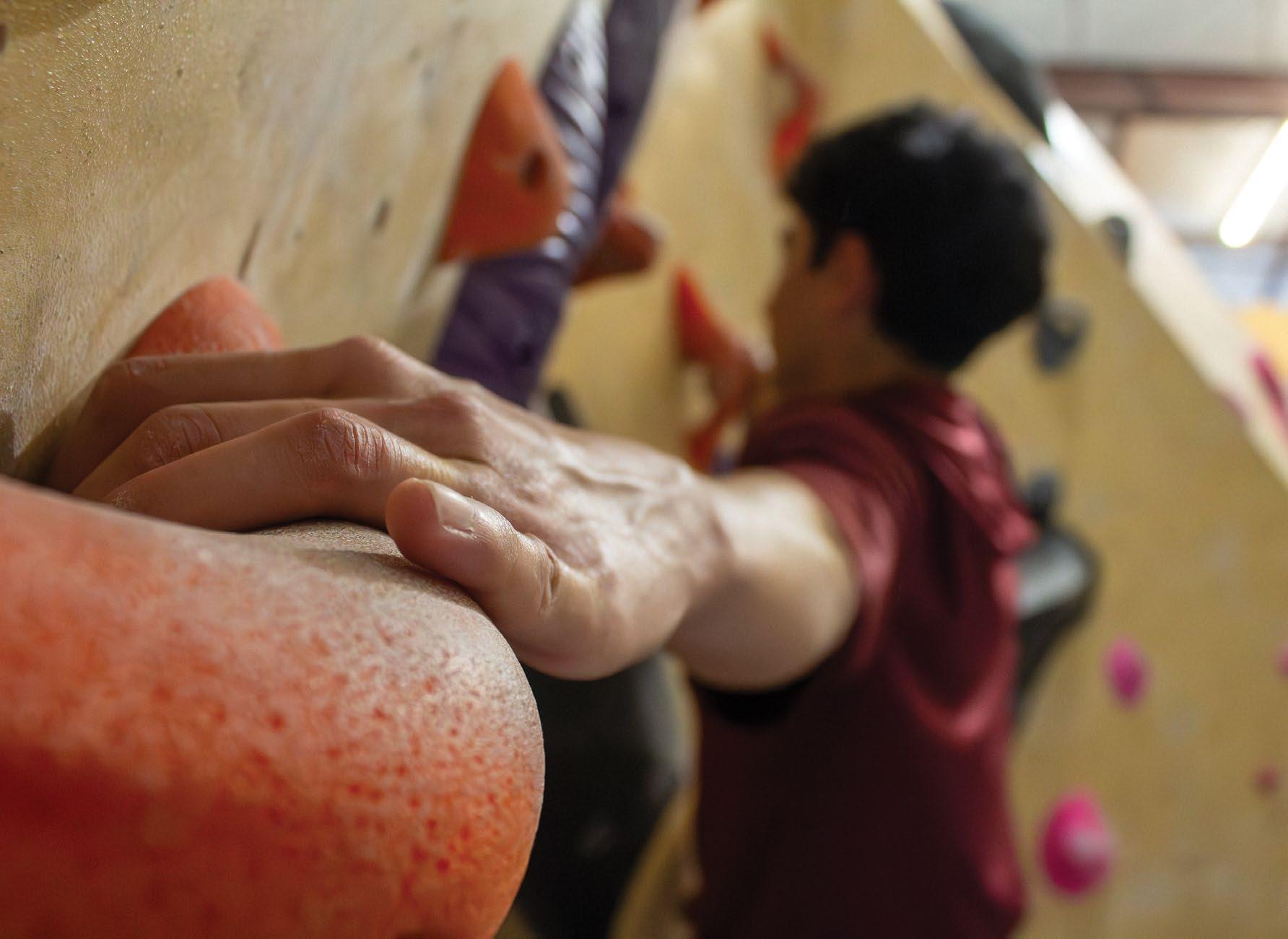OPINION Page 2
Stepping into the world of photography

NEWS Page 4
SISD approves mass layoffs of 300 employees


ARTS & CULTURE Page 7
Beyond the screens, the realities of spring break

SPORTS Page 10
UTEP beach volleyball defeated in home debut


OPINION Page 2
Stepping into the world of photography

NEWS Page 4
SISD approves mass layoffs of 300 employees


ARTS & CULTURE Page 7
Beyond the screens, the realities of spring break

SPORTS Page 10
UTEP beach volleyball defeated in home debut


Throughout the decades, women have existed in a world where the fight for individual rights, acceptance and equality is a constant reality. Women’s History Month started off as a weeklong celebration in Santa Rosa, Calif. in 1978, according to the National Women’s History Museum. Today, women are celebrated throughout March, and in El Paso, women from all backgrounds have spoken up to share their stories.
Diana Natalicio, former president of The University of Texas at El Paso (UTEP) and former professor and activist Dr. Eleanor Duke are just two of the thousands of women that have lived in the El Paso region who have impacted women across the border.
Marathon runner and school counselor at Hornedo Middle

School, Amanda Patrick, says she has faced many hardships throughout her life.
Patrick was born and raised in Las Cruces by her mother and grandmother and moved to El Paso when she was in the fifth grade.
“My mom did whatever it took for me to have the best life possible, she is my biggest cheerleader,” Patrick said. “She empowered me to be the woman that I am today.”
Patrick‘s mother worked as a budget analyst at White Sands Missile Range.
“She’d have to leave at five in the morning and I remember seeing her packing our bags, getting my baby brother in the car to take him to my grandmas in Las Cruces, then drive to White Sands,” Patrick said. “She didn’t complain, she did what she needed to provide for us and seeing her as a single mom made a huge impact in my life.”

When Patrick was in school, she faced many hardships, especially when entering her freshman year at UTEP. After being in college for a year Patrick was pregnant with her first daughter and was forced to drop out. However, she continued and decided to complete her studies in education at El Paso Community College (EPCC), then later returned to UTEP and graduated with her Bachelor of Education in 2011 and started her career as a teacher. After seeing that her students at the time needed extra help outside of the classroom she was inspired to pursue her Master of Education in School Counseling. After receiving her masters she had a difficult time landing a job as a school counselor. So, at the time, after hearing that a position opened at her daughter’s school, she then became a pre-k teacher. After her career developed,
Patrick set a goal to start running and has since met many milestones such as completing full marathons and other running goals.
“I wanted my daughters to see [that] if you have a goal, put a plan in place and stay dedicated, you can accomplish anything,” Patrick said.
As a school counselor at Hornedo Middle School, Patrick has started a running club for the students.
Library archivist and head of UTEP special collections, Claudia Rivers, is another female educator like Patrick, who has been an archivist in El Paso for 30 years.
“I came for a temporary job, from Austin. I had worked at the Benson Latin American Collection at UT Austin and then a job here became open, and I thought, gee, it’s right on the border close to Latin America, I get to use my Spanish every day,” Rivers said.
Rivers was unsure of what was to
become of her career after selling the restaurant she owned in Austin for eight years, so she decided to attend graduate school.
“I thought [of] what kinds of careers would I like to do, and what could I have a professional degree with, just a master’s degree, without having to write a dissertation,” Rivers said. “I knew people who were librarians, and I decided to go to library school and get a master’s in what’s called library and information sciences.”
The decision to get her master’s degree in this field inspired Rivers to become an archivist. Now, Rivers represents the female population in one of the many important roles as a female archivist.
“Women are over half of the population and have really important roles,” Rivers said.

Avery Escamilla-Wendell, editor-in-chief
Entering this world of media and journalism is something that’s still kind of new to me, but in the two years that I’ve being doing this, I think I can confidently say that deciding I want to take my photography seriously and pursue a career in media is the best thing that I could have done for myself.
When I was younger, every time someone would ask me “What do you want to be when you grow up?” and “What are you passionate about?”, I would freeze up and feel like a deer caught in headlights because I truly felt like nothing was for me.
For the longest time, I was so set on pursuing a career in the medical field because that was my safe space. I was in different STEM programs, my endorsement was Biomedical Sciences and I even completed two different clinical certification programs to get my foot in the door to get a job.
To put it dramatically, deep down inside, I knew that I hated where I was and knew I would be miserable for the rest of my life if I was stuck working in the medical field.
I don’t remember much from
‘Cobra
elementary school. One thing I remember so vividly is around third grade being in yearbook and walking around events with my little camera, taking photos and, seeing the outcome and loving the fact that I got to say, “I took this photo.”
I didn’t realize it until recently, as corny as it sounds, that’s something that always lived in the back of my head, it was a defining moment.
Fast forward to my junior year, I got thrown into a graphic design class and the teacher, just so happened to also be the yearbook adviser, and was trying to get people to join his team.
I remember being in such a bad spot at the time and hearing the adviser talk about me joining, and I thought something along the lines of “YOLO I’ve got nothing to lose,” so that’s what I did.
I slowly started to get involved and started to fall in love with it.
Each day that I would leave my medical classes and come down to the yearbook room to work, I felt happy and I loved it so deeply.
I loved the stress, the people, the environment and this new world of media that I was entering.
At the end of my senior year, I remember being so crushed and torn when it was time to say good-
bye to not only the people I met in yearbook, but to leave something I finally found myself enjoying doing. My adviser, Justin Stene, pushed me to keep going and apply to The Prospector because he believed in me and the potential I had, which I am so grateful for.
My first semester of college I ended up joining both The Prospector and Minero Magazine as a photo contributor with so much fear, feeling like a scared little mouse scurrying into the office.
Now I am the photo editor of both publications still creating content that I love, and as many times as I want to curl up and sob trying to manage myself, I love every second of it.
These two publications have truly shown me so many new things both in and outside of media in the year and a half that I’ve been here.
Although I am still finding myself in this journey, I am so very grateful for the experiences and people that it has brought along the way. I hope to help create these same experiences for people starting off feeling like how I once did.
Iziah Moreno is photo editor and may be reached at iamorenogavald@miners.utep.edu

“Cobra Kai” ended with a swift leg sweep in the feels within the six-episode finale released on Feb. 13. It tied together decades worth of karate drama, dating back to the release of “The Karate Kid” (1984) rivalry between Daniel LaRusso and Johnny Lawrence.
Viewers and fans across forums such as Reddit and X were worried six episodes was not enough to conclude the stories of each main character, but the writers did an amazing job tying up the characters’ story lines with minimal questions. Throughout the six seasons of “Cobra Kai”, it is notable that each main character has their distinct background. Characters like Miguel Diaz and Tory Nichols
come from a place of immense struggle in aspects of parental sickness, immigration or simply being led down the wrong path. On the contrary, characters Samantha LaRusso and Eli Moskowitz come from backgrounds of wealth and fortune. Looking back at “The Karate Kid”, LaRusso and Lawrence also came from dramatically different backgrounds as well.
Although some characters might have grown up with more fortune than others, the show does an excellent job showing viewers that everyone struggles in one way or another. It doesn’t matter who you are or where you’re from, showcasing each character’s struggle, both in and out of the dojo.
We see most of our characters going through their teen years
throughout all six seasons. The way these teenagers handled their adversities was written excellently throughout the show. Their adversities range from picking colleges to ending up in jail, and even the immense grief of losing a parent. The writers had their way of showing the severity of certain adversities.
Each one of the new main characters’ backgrounds and lives intersect to bring them to one common denominator: karate. One could say that karate was a stress reliever for some characters, a way to defend themselves, but their lessons in martial arts always had application in their everyday lives
The sense of loyalty to each of the dojos in the show makes and breaks many of the characters, bringing on unexpected relationships and the
Adrienne Garcia, Account Executive
Ana Flores, Advertising Coordinator
Ryan Leblanc, Advertising Coordinator
Elias Segura, Advertising Videographer
CONTRIBUTORS
Sadie Briones
Jazmine Gracia
Kristian Hernandez H. Catching Marginot Yael Marquez Cameron Mason Daniela Ordaz Athan Sano
Victoria Valdez
Vianah Vasquez
ends of rivalries through reconciliation and even death. The mix of fighting styles from all three dojos, offensive and defensive, brought a higher sense of knowledge to the characters, allowing them to find balance in their lives.
Through new and old characters, we see the application of martial arts drastically affect lives and values, and it is tied up almost perfectly in the final season where they compete in the worldwide karate competition, the “Sekai Taikai.”
The “Sekai Taikai” and its events were the perfect tournament to tie up the show and its plot lines. Everyone is present and watching. The stakes are high, and the tournament is the determining factor of many characters’ futures.
The inner strength and difficult
decisions mustered up by the new generation of characters are all displayed in such different ways. The lessons from each dojo really come into play and each character chooses a direction to lean into, not because of karate politics, but because they’ve become aware of what’s best for not just themselves, but others too.
The legacies of old characters, especially Mr. Miyagi, are carried so well in Cobra Kai’s writing and conclusion. Miyagi’s ultimate stance on karate, to only use it when it’s needed, brought us many subtle, but extremely powerful full-circle moments.
read MORE at theprospectordaily.com
for hands-on learning, professional networking and increased job prospects.
Internships have become an unofficial requirement for success in today’s job market. At the University of Texas at El Paso (UTEP), students are encouraged, if not pressured, to complete one before graduation. While internships can provide career advantages, they are not always accessible, effective or necessary for every major.
Instead of treating internships as the only pathway to career readiness, universities should expand their approach to professional development. They can offer valuable experience but should not be the default expectation for all students.
Julio Garcia, a mechanical engineering major at UTEP, understands both the benefits and the challenges of securing an internship as someone who has experienced the competitive nature of them.
“There are a lot of internships, but, there are also a lot of people going for the same things, and since it is very saturated, there are less chances of you actually getting the job. Even currently right now, me looking for jobs has gotten a lot harder, even though I’ve applied for a lot of them,” Garcia said. Internships provide opportunities
According to the National Association of Colleges and Employers, students who complete internships are more likely to secure full-time employment after graduation.
For those in STEM, business and healthcare, internships often serve as a direct pathway into the workforce. Some students even transition from internships to permanent positions at the company. This approach, however, does not work similarly for all majors. Liberal arts, humanities and other theoretical fields often lack structured internship opportunities, leaving students with limited options for gaining professional experience outside of school.
Alternative career-prep options, such as research projects, industry-sponsored course work and apprenticeships, provide practical experience while addressing gaps left out by traditional internships.

job rather than an internship. He believes work experience is just as valuable, if not more, than a traditional internship.
Fidel Elkabchi, a computer science major at UTEP, has a different perspective, as he has gained work experience through his Informational Technology (IT)
“While I haven’t completed an internship at UTEP, I have been working locally in IT for four years now, and I’d say it made me more confident in professional settings,
and I think employers always look for that sort of thing,” Elkabchi said.
Financial accessibility remains a significant concern. Many internships are unpaid or offer stipends too small to cover living expenses.
While UTEP provides some funding through the Career Center and academic credit for internships, these resources do not resolve students’ financial burdens.
Internships often favor those who can afford to work without pay, creating an uneven playing field. Students managing tuition, rent and part-time jobs frequently turn down internships because they cannot afford to work without compensation.
On top of little to no income from internships, burnout is another overlooked issue.
Many UTEP students work to support themselves or their families while attending school full-time. Adding an unpaid internship to an already demanding schedule contributes to more stress.
Some students spend hours at internships performing administrative tasks rather than developing relevant industry skills. If the goal of an internship is career preparation, companies must be
held to higher standards to ensure interns receive meaningful training and professional development.
“Some of the challenges I faced were definitely the workload. When you work in things like IT or computers that need a lot of maintenance, it’s easy to get overwhelmed, but dealing with that stress now will prepare you for the stress after college,” Elkabchi said.
UTEP has made significant efforts to connect students with internships, but expanding career development options could provide even more important benefits. Research assistantships, project-based coursework and university-led apprenticeships offer valuable hands-on experience while accommodating different financial and scheduling needs.
Employers play a key role in this process by ensuring that internships are structured to provide training and fair compensation.
Internships will continue to be essential to career preparation, but they should be one of many pathways available to students. By diversifying professional development opportunities, UTEP can support a broader range of students and help them gain the skills and experience necessary for success in their chosen fields.
SalmaPaola Baca is a staff photographer. She

Students, parents and community
members filled the Socorro Independent School District (SISD) Service Center on the evening of Feb. 19, pleading for the school board to not eliminate fine arts in schools to deal with a budget deficit. Speakers went up to the podium one by one defending the fine arts programs and warning of potential implications if they move forward with their plan to lay off their employees.
After five hours, the school board voted 3-2 to move forward with recommendations from Interim Superintendent James Vasquez to eliminate elementary fine arts programs, increase class sizes and layoff an estimated 300 employees, according to El Paso Matters.
Trustees, Michael Najera, Cynthia Najera and Alice Gardea, voted in favor of the plan, according to El Paso Matters, while Marivel Macias and Paul Macias voted against.
This decision will increase elementary school class sizes from 22 to 24 students, while middle schools will expect an increase of 24 to 26 students per class.
District officials estimate that this decision would generate
approximately $30 million in savings for the district while also leaving $8 million to address budget undersupply and aid in strengthening their financial reserves, according to KTSM.
SISD is starting to ask voters to consider an idea of a “penny swap” deal later this year to move property tax rate money aside to use in general operations to repay debt. If this is approved, the swap will not affect the tax rate but will generate an additional $28 million in revenue for the district, according to El Paso Matters.
During a press conference last week, state appointed conservator Andrew Kim stated that he’d investigate the current enrollment and performance to decide what positions to cut. He stated that approximately 3,000 students are graduating from the school district but only 2,500 students enroll at the kindergarten level. However, the district blames low birth rates, excessive absences and inadequate state funding for said reductions, according to KFOX.
Starting March 7, the district will decide who to lay off and notify employees by April 1.
Frank Martinez, a retired teacher who taught for several years in

the El Paso Independent School District (EPISD), expressed his delight in watching the audience stand up for education.
“I love what all the participants are doing and what they are saying is true,” Martinez said. “It’s going on all over the country and it’s representative of all the problems that are going on. There are too many people in the business trying to run instead of having people who know what’s going on that are involved in education.”
Martinez’s wife, Linda Martinez, who worked as a dispatcher for the maintenance department under EPISD, believes teachers are not
just numbers of a population on school campus.
“They are always there to help students, and I feel that they should be there for students and shouldn’t be removed. They are not just numbers and like one of the students said, ‘If it weren’t for them, we wouldn’t be succeeding’,” Martinez said.
Vasquez explained in a press conference that layoffs were necessary to make a stronger effort to fix the shortfall in the district’s budget and prevent a state takeover.
“We made the decision that was in the best interest of the district as a whole to save us from a financial
exigency,” Vasquez said.
Holding a poster outside of the conference displaying his discontent with the decision of the district, local artist Ivan Calderon believes that teachers not only provide education for students but also pave the way to artistic careers.
“As a local artist, all my primary instructors in art were very beneficial to my career. Most people don’t realize it, but the art industry is much bigger than Hollywood productions and the music industry combined, there’s so much value to what people are just crediting right now inside the school board,” Calderon said.
With SISD making a firm decision on proceeding with budget cuts, increased class sizes and hundreds of layoffs, the SISD community holds fear and disappointment with what could happen as an outcome of the vote.
The community not only worries about the future of education in the district, but also how students cannot proceed with their artistic endeavors and aspirations and will lose the individuals who helped them pursue their dreams and ignite their passion for the arts.
Ordaz is a contributor for The Prospector and may be reached at drordaz@miners.utep.edu.














In early February, President Donald Trump’s Department of Government Efficiency (DOGE), shutdown the United States Agency for International Development (USAID), the world’s largest supplier of foreign assistance, propelling the Department’s desire to stop “waste and fraud.” Some students at UTEP are concerned about the employment cuts.
While a federal judge ruled that the Trump administration must return funding to USAID, DOGE– a renaming of the previous United States Digital Service– has kept pushing the boundaries of law, causing debate over whether America is in a constitutional crisis.
DOGE’s actions include and are not limited to, cutting $900 million from the Department of Education, voiding 2,300 government contracts, a number of which were research grants for universities, and eliminating roles for over 200,000 federal workers.
“I originally wanted to work for the government but these steps that they are taking, makes me think twice,” freshman Felix Castañon, an aerospace engineering major at UTEP said. “The limited amount of positions, it’s limiting my chance as a person who wants to be an

employee for the government.”
In regard to employees and the government, The White House came out publicly at the beginning of February and stated that Elon Musk, owner of Tesla, is now serving as an adviser role to the president, also referred to as, “a special government employee” by Karoline Leavitt, White House Press Secretary.
Elon Musk also appeared at this year’s CPAC, where he wielded a chainsaw and said, “This is the chainsaw for bureaucracy,” referring to the slashes DOGE has made, to the government employees laid off.
Tim Abdirshin, an international
student from Kazakhstan says there is going to be less space for corruption to occur and agrees with Musk as a government employee.
“He will probably let more international [students] into his companies, he’s pretty wealthy, so he won’t probably act more negative about it.”
When DOGE gained access to sensitive information from the treasury, alarms were sounded for Democrats, and constituents in red counties. According to Trump’s executive order, DOGE was described as “modernizing federal technology and software to maximize governmental efficiency
and productivity.”
Shortly after a federal judge stopped DOGE’s access to the federal payment system, DOGE cut 5,400 probationary workers from the Department of Defense, and over 1,000 employees from the Department of Veterans Affairs and the National Park Service. Federal workers also received an email that requested them to list what they did in the past week, adding that “failure to respond will be taken as resignation.”
Secretary of State, Marco Rubio and FBI Director, Kash Patel told their employees to not respond to the email. Pete Hegseth, leader of
the department of defense, Tulsi Gabbard, director of national intelligence, and Kristi Noem, leader of the Department of Homeland Security, all followed suit in telling their employees to ignore the message.
On Tuesday, Feb.25, hours after Musk’s deadline for replies to his email, 21 DOGE employees resigned from their positions, leaving a letter for White House Chief of Staff, Susie Wiles. The workers cited their want to uphold the constitution, their disdain in their colleagues who were working to “modernize Social Security, veterans’ services, and tax filing.” The letter said a third of their colleagues were “indiscriminately terminated” and how the departments firing of technical experts, paired with “mishandling” of sensitive data is not compatible with the “mission we joined the United States Digital Service to carry out.”
“We will not use our skills as technologists to compromise core government systems, jeopardize Americans’ sensitive data, or dismantle critical public services,” As the government undergoes changes, aspiring employees debate whether to pivot their future or still join the federal workforce.

The University of Texas at El Paso (UTEP) Women and Gender Studies Department established “Pete’s Plate” a collaboration with Mustard Seed Café offering free meals to the UTEP community.
The Mustard Seed Café, is a nonprofit organization and donation-based cafe. The cafe has different meals each day with the mission of providing those in need with food security.
The Mustard Seed Café website states, “We serve delicious, nutritious food with an accompanying commitment to recognize the dignity of each guest and treat them with respect. There are no set menus, no prices or requirements for our guests.”
“Pete’s Plate” works in a very similar way to the café. New meals are distributed to students each day of the week with all students welcome to come in at whatever time fits into their schedule. On top of the meals, the Women’s and Gender Studies office also has snacks and other quick meals for students who may be in a hurry.
The Women’s and Gender Studies department is not only providing meals and snacks for all students but is also providing students with hygiene items. The goal of the department is to provide students food and hygiene secure as this can aid students to the path of finishing their chosen degree.
Danae Murphy, a biomedical science student at UTEP, sees the Pete’s Plates program as positive support for those attending the university.

“I think it could help, because if there’s people that can’t necessarily afford (meals), if they don’t have enough money or if they have problems they can’t necessarily control in their life,” Murphy said.
“It’s very important for extra help.
I think it could lead to someone’s success because it gives them the benefit to get everything they need and have that extra support that they could stand on.”
Around 35% of El Pasoans and 61% of UTEP students faced food insecurity, according to a research study done by UTEP and El Pasoans Fighting Hunger. For those attending UTEP, students with food or even basic needs insecurity, such as housing, hygiene items, and health, are
approximately 43% less likely to finish their degree.
To combat this idea Director of the Women’s and Gender studies department Hilda Ontiveros, finds their program a necessary one for student success.
“We should be the guardians of our community. Our community is UTEP. What we’re doing is feeding the community, the UTEP community. To fill a very large need at the university.”
The Women’s and Gender Studies Department can be found in the Liberal Arts Building in room 233, with available resources from 8 a.m. to 5 p.m., Monday through Friday to students, faculty and staff.
Joseph Montero is a staff reporter for The Prospector and may be reached at jemontero@miners.utep.edu
optimism to become leaders in their own communities and circles.
The Undergraduate Learning Center at UTEP was filled with several students participating in the 2025 Miners Leadership Summit on Feb. 28, pushing students to take part in activities that strengthen their leadership.
The Miner Leadership Summit included multiple breakout sessions, a keynote speaker presentation and networking opportunities.
This year’s Miner Leadership Summit featured keynote speaker Nyle DiMarco, winner of “Dancing with the Stars” and “America’s Next Top Model,” and session facilitators including UTEP head football coach Scotty Walden, UTEP head volleyball coach Ben Wallis and more speakers.
The speakers focused on various topics, such as how to push past obstacles to achieve goals and dreams, developing leadership skills in various settings, building a foundation, and more. Students were encouraged to apply the advice and lessons highlighted during presentations in their own organizations or lives, pushing them to develop courage and
Ph.D. Chemistry student Kazi Saima Banu explained that she felt like the leadership summit had helped her break out of her comfort zone and meet new people.
“I like it very much and last year I registered, but I couldn’t be there the [whole] time because of class and research,” Banu said. “I came because it’s a nice place to meet new people and the breakout sessions help you break out of your comfort zone and talk to new people.”
Mechanical Engineering student David Semiday, wrote down notes from the workshops and keynote speaker series, reflecting on how the leadership summit personally encouraged him to apply these skills in his everyday life.
“This definitely made me aware about how I can take charge of my education,” Semiday said. “The use of leadership and implementing that into everyday life and also changing things up about you like your work ethic, how you tend to talk to yourself and how you tend to think about yourself.”


Alyda Muela, editor
Editor’s Note: This is the first partofathree-partseriescovering the cultural roots of cafecitos in Socorro, Texas.
Incense cleanses the energy of a small adobe coffee house, Café Piro. With Native American art and culture displayed unabashedly, visitors are greeted with a scent of citrus and a warm welcome by the owners and baristas, who aim to satisfy the stomachs and brains of their patrons through the café’s cultural experience.
The adobe coffee shop was established in 2022 by owners Gabe and Mel Padilla after years of running a barbecue food truck. It is one of three shops in the Socorro district that is uniquely rooted in Native American culture.
Gabe and Mel Padilla say the inspiration for the café came from a need to pay homage to their Piro heritage, a tribe native to the Socorro region.
The Piro’s pueblos were located within Socorro and the Rio Grande Valley. They were one of the first tribes to have a run-in with the Spanish colonists who
resettled their pueblos.
Mel Padilla says she was part of the first generation in her lineage who did not have to be a farm worker, so she wanted to show that working hard was engrained in her.
The café’s menu tells big stories.
The Padilla’s said that their vegetarian dishes reflect the way the Piro tribe used to live. They relied mostly on the fruits, vegetables and grains they gathered for their meals when meat was scarce.
“There wasn’t too much meat. Just whatever (the natives) could hunt. There were a lot of soups, stews—a lot of survival type of dishes. Meats were a luxury,” Gabe said.
Their items include egpai, a quiche with goat cheese and sundried tomatoes, fresh fruit bowls, mushroom tacos and one of their most notable items, the tres hermanas pozole, a vegetarian dish made up of beans, corn, seeds and squash. The Padillas say this dish is a direct reflection of their heritage and tribe.
“In indigenous culture, the three sisters are beans, corn and squash,” Gabe said.
They say one can imagine the dedication put into every meal


anything that comes out of a can or is frozen,” Mel said. “We honor our ancestors by making sure everything we’re doing is made with our hands.”
They say they also keep the tradition alive by sourcing locally.
“We source our beans from a woman-owned coffee roaster,” Mel said. “We want to make sure our money is going to people who are small, not big corporations. We source locally as much as we can.”
One of their signature drinks is the marranito, an old fashioned orange creamsicle latte. Mel says this one came about from her personal experiences.
“The marranito latte, I hold close to my heart, because that was one of the things my grandma would feed us when we were kids. It was kind of a cookie nobody wanted to eat, so I wanted to implement that into a version you did want to drink,” Mel said.
Alongside the food and drinks, the Padilla’s say art and community play a major role in Socorro.
“The art on the walls are (from) people we know. They’re our
friends,” Mel said. “We contribute to the artists by not charging commission when their art sells. All proceeds go to the artist. We wanted to break the dynamic that artists are starving.”
They also bring art to the community through the popular pottery nights that Mel hosts with an evening of playing with clay, good conversation and fun drinks.
“We’ve made lots of friends along the way. That’s our version of creating a community,” Mel said.
Café Piro has created a flow of new and returning customers by treating each one as a friend while sharing the Padilla’s love for their heritage and fresh food. The values and culture of the owners and Socorro have become wrapped into one unique coffee shop in an old adobe house on 9993 Socorro Road in Socorro, Texas.
Jesie Garcia is a staff reporter and may be reached at jlgarcia36@miners.utep.edu or on Instagram @empanaditawrites.
Map of Piro pueblos 1300s-1600s

THE PROSPECTOR JAZMINE GRACIA B Y
Noise fills in the silence as one prioritizes ambient sounds to create a relaxed and focused environment.
Ambient films are unique in their creation as they prioritize an atmospheric immersion that

publications like Screen Rant and Reddit, where

Casino Pool, the first Olympic-size swimming pool in Florida.
Spring break– the one week in March when college students get a break from school and get to party Project X-style, but the media’s depiction of this annual vacation period may not be all of what it’s made out to be.
Movies like Harmony Korine’s “Spring Breakers” (2012) and songs like Charli XCX’s “Spring Breakers” (2024), which alludes to the film, have glamorized the western tradition, tying it to expectations of a party lifestyle.
The concept of spring break began in 1936 when a Colgate University swim coach took his team to Florida for a week-long winter training session.
Sam Ingram, head coach of the Colgate University swim team, brought his team to Fort Lauderdale, Fla. to train at the
Two years later, the city saw a beneficial marketing move from Coach Ingram’s choice and hosted a swimmer’s event at the pool. This strategy attracted large amounts of people and soon the start of the spring break culture began.
Since then, it has gained popularity and has grown into a mainstream tradition with different versions of the week existing at every college and most schools.
At UTEP, the experience of spring break tends to be more laid-back compared to other universities.
For students like junior Marissa Patterson, it’s a time to relax, unwind and not worry about classes rather than catching flights and partying like there’s no tomorrow.
“I don’t think it does (live up to the hype),” Patterson said. read MORE at theprospectordaily.com
lists of movies compatible with the interest of filling the silence have been compiled.
According to Professor Lisa Elliott, professor of mass communication at El Paso Community College (EPCC), there is an intimacy in choosing a film that corresponds with your desires. Selecting an ambient medium is considered to be a deep and intentional process.
“Ambience is something that you’re curating yourself and choosing to put on to give additional stimulation to your environment, whether that’s to make you feel more focused or drown out other noises,” Elliott said. “What’s interesting about them is they offer a different kind of engagement. You could use them to engage visually and in a meditative state.”
Even as background noise, there is an intricacy involved in selecting what film you would like to fill the space, whether that be to enhance organic sounds or drown undesirable ones. The craftsmanship behind an ambient film’s soundscape lies in its use of authentic sounds that can be maneuvered by the viewer.
Background noise has been an essential part of some students’ routines to ensure maximum productivity. By searching for a film
that complements the atmosphere, they are trying to create a sacred practice that is curated by the intimate process of selecting the perfect film.
Anthony Quezada, a physical therapist major at EPCC, utilizes film as a consistent stimulant that both comforts and encourages him. Depending on the assignment, Quezada will choose a film that complements the homework and aligns with the environment he deems appropriate.
“I look for something comforting and familiar. If it’s a creative assignment like a poem, short story, or art piece, I will try to pair it with a movie or TV show that has a similar feeling I want to draw from. It can‘t be too stimulating or something to really pay attention to too much,” Quezada said.
With the presence of televisions in the household and the introduction of streaming services, concerns have sprouted about how the film landscape could shift and how the prioritization of audio can trump the visual aspects of film.
“I think to contextualize there are positives and negatives. I think one of the positives is you can have a film and watch it a lot of times,” Elliott said.
As media consumption continues to evolve, concerns over the decline read MORE at theprospectordaily.com
The chatter of excited guests, the crash of bowling pins being knocked down and sounds of arcade games humming fill the air–Gamescape by Cinemark officially opened its first location in El Paso, Texas, on Feb. 20.
The venue offers a new all-inone entertainment location that includes bowling, laser tag, an arcade equipped with a climbing wall and ropes course, a full-service restaurant and bar and the latest movie releases. Already drawing comparisons to its competitors, visitors like 20-year-old Andres Favela say that Gamescape has much more to offer.
“Honestly, I think this place is way better than Dave & Buster’s, it’s got everything like laser tag, wall climbing, bowling– it’s got a movie theater,” Favela said.
For some El Paso residents, Gamescape is a welcome addition to the city’s entertainment scene, as a one-stop shop for a variety of activities. According to 19-year-old Iliana Guevara, Gamescape brings something fresh and fun to El Paso.
“We were so used to little options like the mall and Dave & Buster’s.” Guevara said. “I think it’s cool because if you get bored of maybe the arcade you can go bowling or (play) laser tag.”
Other guests like Evan Orozco, 19, say the variety of activities make the venue an appealing option for parties and group gatherings.
“It’s pretty cool, there’s a lot of variety and looks like a cool place for a birthday party,” Orozco said.

Gamescape’s arrival in El Paso could have a broader economic impact. As a family entertainment center (FEC), Gamescape provides year-round attractions and reduces the seasonal downturn seen in other venues.
According to Walltopia, the shift in consumer behavior, particularly with younger generations such as Millennials and Gen Z, shows that consumers are more drawn towards experiences that foster social interaction rather than material possessions. Places like Gamescape may find themselves to be a hot commodity around town.
As said by Walltopia, “The broader trend of the ‘experience economy’ has further accelerated the growth of FECs…FECs–with their wide range of attractions–serve as the perfect venue for these shared experiences.”
Beyond its entertainment options,
Gamescape’s menu was carefully curated to incorporate regional inspired flavors in addition to the traditional entertainment food items like pizza and burgers. Some region-specific items include beef birria pizza, street corn pizza with cotija cheese, and loaded tamales that include Cinemark Slap Sauce™.
“This is a menu that we put together really strategically,” Public relations manager for Cinemark, Julia McCartha told KVIA. “We also wanted to incorporate a lot of the local flavors as well.”
With its mix of movies, games, activities, and locally inspired food, Gamescape may be setting itself up to be more than just a spring break hotspot–it just might become a go-to entertainment destination for El Pasoans year-round.
Sofia Sierra, editor
JESIE GARCIA B Y
REPORTER THE PROSPECTOR
The warm sun of the early morning during the spring is a call to action to college students, especially those who are into hiking. It’s time for them to throw on a pair of heavy boots, pack water and sandwiches as they head into the mountains for a day of fresh air and desert views.
Though climbs can sometimes be rigorous, the challenge provides benefits to hikers even beyond physical health. It makes for an activity to keep busy, active and it a serves as a picker-upper to many hikers new and old.
Even though West Texas trails can be treacherous, the scenic views and unique flora and fauna make the paths appealing to new hikers and keeps old hikers coming back for more adventure.
The West Texas region has
an abundance of hiking trails throughout its state and national parks such as the Guadalupe Mountains National Park and the Franklin Mountains State Park, that have a variety of climbs, canyons and nature trails to view wildlife in the area.
The trails are home to an abundance of desert ecosystems that give life to the miles of dirt.
The flora and fauna range from rattle snakes and squirrels to numerous succulents and cacti.
Seasoned hikers like Alyson Rodriguez, 23, and a hiker of 13 years loves the rush of a good trail as it means much more than just a workout to get some steps in.
“It doesn’t even feel like a workout, but more like an adventure,” Rodriguez said. “I always get to see something new whether it’s a new trail I’ve never been on or a trail I’ve been going to for years. Either way, it always feels
like I accomplished a challenge after a hike.”
She said the experience of hiking in the west region has not only been fulfilling to her but thinks the desert hikes are a unique experience for everyone to have.
“Hiking might not be for everyone, but I hope everyone hikes at least once on one of the trails [in El Paso]. It’s a great way to appreciate nature and all its glory,” Rodriguez said.
The feeling of accomplishment does great things beyond a good workout for hikers like Axel Perez, 20, who has five years worth of experience. Although the hot desert sun and slippery rocks are a barrier to most, the natural surroundings are comforting to him despite the sometimes strenuous conditions.
“Hiking plays a huge role in maintaining my mental health. Being in nature, seeing beautiful landscapes and exploring different
places helps me feel relaxed and happy,” Perez said.
Hikers like Rodriguez also use the activity as a coping mechanism to forget the worries of the day-to-day and get lost in the Earth’s creations.
“It helped me become stronger both mentally and physically,” Rodriguez said. “When I lived here in El Paso, whenever I was stressed or sad I would just put on my hiking boots and bring my dog on a hike with me. I would completely forget what I was all worked up about and just be in awe of how pretty the view on the trail was. I would get my dopamine up because I was exercising.”
Perez makes it a point to hike every weekend to challenge himself or to spend time with good company by taking friends and family and take in the beauty of the terrain of the frontera.
“Getting to experience nature at its finest, exploring breathtaking
places and connecting with other hikers–the hiking community is so welcoming, and it’s easy to meet like-minded people,” Perez said. “El Paso has so many amazing trails like the Tin Mines or Thousand Step Trail, which offer a perfect mix of nature and city views.”
Rodriguez and Perez recommend for new hikers to just get out there and get the initial fear of hiking over with to enjoy a potentially lifelong hobby.
Jesie Garcia is a staff reporter and may be reached at jlgarcia36@miners.utep.edu or on Instagram @ empanaditawrites.


Throughout the McKelligon Canyon trail, there are several landmarks scattered to ensure that hikers do not lose sight of the path and get lost.
An intense back and forth between UTEP men’s basketball (17-12, 7-9 Conference USA) and the Middle Tennessee Blue Raiders (20-9, 11-5 Conference USA) took place on March 1. Both on top of their game, UTEP led Middle Tennessee for the first 35 minutes into the final moments of the game. Senior forward Otis Frazier III would help send the game
into overtime after two crucial 3-pointers from the Blue Raiders.
The Miners would ultimately fall to the Blue Raiders in overtime marking UTEP’ s first Senior Day loss in five years.
UTEP Head Coach Joe Golding gave credit where it was due for the Miners and their hustle against Middle Tennessee.
“I just feel for our guys, I thought they gave it everything that they had,” Golding said. “Give them credit, they hit big shots, they made
some good plays. We’ve got to get to the finish line, I thought it was a good college basketball game.”
The Blue Raiders came out strong, with a quick lead of 4-0 out of the gate. From there, the back and forth started promptly with each team scoring vigorously. The Miners knew they had to turn up the heat offensively, prompting Frazier and senior forward Kevin Kalu to ignite that fuse.
The team followed suit, with junior guard Ahamad Bynum
making a 3-pointer pulling UTEP to tie at 7. Soon, with shooting help from junior guard Devon Barnes, the Miners were able to slowly but surely work their way up the scoreboard to catch up.
Bynum would eventually knock down a jumper to put UTEP up five points, but a late 3-pointer from the Blue Raiders would put the score 33-31 by the end of the first half.
The second half would start with a boom from the Miners with an
alley-oop from Kalu. However, the tight competition in the previous two quarters would follow into the third too.
A burst of five straight points from UTEP would help throw off Middle Tennessee. Kalu would slam a shot from the paint, with a triple from Bynum quickly after. Soon a timeout would be called from Middle Tennessee, but this didn’t stop Kalu from squeezing in one more dunk for good measure.
For students looking to stay active during their mid-semester break, rock climbing is an option that combines both teamwork and physical activity.
Rock climbing was originally created as a means of transportation and exploration, but over time has turned into not only a sport but a recreational hobby practiced by many.
Hueco Tanks, a state park nationally recognized for its rock climbing landscape, has been home to many climbers and thrill seekers. However, if one isn’t interested in being outdoors, an indoor climbing gym is the perfect solution for both beginners and veteran climbers.
There are two climbing gyms in El Paso currently available to the community. Located at the University of Texas at El Paso (UTEP)’s student recreation center, the university has its very own indoor climbing gym.
Students can enter by showing their student ID at the UTEP Student Recreation Center’s front desk and simply head downstairs for open climb from 1 p.m. to 7 p.m., Monday through Friday. For those who are interested in climbing to greater heights, Belay School is also held in UTEP’s
recreation center’s climbing gym from 5 p.m. to 7 p.m. on Wednesday and Thursday.
The second climbing gym is located on the west side of El Paso, called Sessions Climbing + Fitness and is home to El Paso’s largest bouldering and top rope climbing walls, and more.
Sessions’ climbing gym offers guests both monthly memberships and individual day pass for unlimited climbing. Climbing shoes can be rented as well as harnesses for top rope climbing which is a straight shot to the top.
The two climbing types offered at the gym are “bouldering” which involves climbing routes with safety crash pads underneath and “walls” that are meant to be used with a harness and reaches heights of three stories high.
Dominic Troiani, a master’s student at UTEP, thinks that rock climbing is unlike any other sport and feels that it is a great physical activity and a perfect way to stay active during spring break.
“It’s like a different way of exercising. It’s not like your traditional running or weightlifting, it helps with mobility, so it’s just a fun way to incorporate that,” Troiani said.
Other students like Manuel Gutierez, the president of the rockclimbing club at UTEP, find rock

climbing to be an activity open for everyone to try, especially with the rock climbing community being extremely inviting.
“It’s very easy to come in, get some shoes, get a harness and start climbing. The climbing community is one of the greatest communities, because they’re all super friendly,”
Gutierez said. “I think climbing is one of those sports where you learn a lot more about yourself because there is no sport where you fail the most besides climbing. Doing it again and doing it better every single time.”
Climbing is an open-arms community, looking for others who are willing to reach greater heights. Although there are only two climbing gyms in El Paso, local climbers come together to share their love for the sport.
Joseph Montero is a staff reporter for The Prospector and may be reached at jemontero@miners.utep.edu
The UTEP Miners (6-4, 2-0 Conference USA) lost 3-2 against the Boise State University (BSU) Broncos (3-2, 0-0 Southland Conference) in their home debut.
The fifth game had UTEP freshmen Lauren Perry and Emma Schubert play against Boise State. Although the freshman duo lost the first set 21-18, they were able
to tie the game 1-1 after winning the second set 21-15. The Broncos were victorious overall, winning the third set 15-13.
Game four’s pair was made up of Miners Kennedy Llewellyn and Reese Rich. Ultimately, the freshmen could not build up any momentum due to losing the first set 21-13. UTEP would subsequently lose the second set 2112 making the overall score 2-0.


Game three featured UTEP graduate student Marian Ovalle and sophomore Mila Popovic. They won their first set in a close score tallying at 21-19. Set two witnessed a decisive victory from the Miners ending with the score 21-12 bringing the overall score to 2-1, motivating UTEP with their first UTEP’s second game duo consisted of seniors Madison Hill and Ema Uskokovic. The pair won the first set 21-17 and this spark continued into the second. In a close battle with BSU, the Miner pair won set two 22-20 bummping up the
Game one was the end-all be-all for both teams. UTEP utilized juniors Krista Paegle and Paulina Acuna to go head-to-head with Boise State for the deciding matchup. The Miners had not lost a set since game four. The junior pair lost set one 21-18 and the Miners’ spark from the previous two games seemed to fizzle with the second set going to BSU 21-15.
The overall score ended at 3-2 concluding with BSU getting the win at UTEP’s courts. The Miners’ next matchup will be on the road for the Malibu Invite March 14 against Sacramento State.
Kristian Hernandez is a contributing photographer and may be reached at kahernandez16@miners.utep.edu and on Instagram @northeastvideography.
From being a 15-year-old exploring a male-dominated sport to becoming the leader of an allfemale team, UTEP Rifle Head Coach Andrea Palafox carved her path in a sports world dominated by men.
Palafox’s shooting career began during her time growing up in Mexico. The passion and love that the men in her family held for the sport influenced Palafox’s own love for shooting but getting her foot in the door wasn’t an easy start.
“I had to basically beg my dad to let me do the same things that they were doing, and it was very difficult because he didn’t think that it was something for women, especially for a little girl,” Palafox said. “Back then at least, in Mexico, it was mostly a guy environment, not a lot of women and young kids were doing [rifle].”
Palafox said she was determined to follow in her family’s footsteps and pick up the sport even though she was discouraged to do so.
Eventually with her father’s guidance, Palafox joined her family in training even though she was younger and smaller than the rest.
“I couldn’t even lift a rifle and hold it, but he found ways to help me get stronger,” Palafox said.
“Once he saw that I was interested and my effort grew, he was like, ‘Okay, let’s try this,’ and he started getting equipment for me. Ever since then, I can’t stop [shooting].”
During her time competing in events at the national level, Palafox’s skill caught the attention of former UTEP rifle coach, George Brenzovich, and was offered a scholarship to be a part of the team from 2009-2012.
Throughout her time at the University of Texas at El Paso (UTEP) as a student athlete, Palafox helped the Miners finish fifth in the 2012 NCAA Championships, a record that stands to this day.
“At first, I didn’t know anything about this type of opportunity. When he [Brenzovich] offered me a scholarship, it was something I wanted without even knowing [it] existed,” Palafox said.
Although she had to deal with a language barrier and the adjustment to university at UTEP, Palafox said the love for rifle and competition pushed her through the obstacles.
Palafox is one of two female head
coaches of a sports team at UTEP, the other being women’s basketball Head Coach Keitha Adams.
“Just the fact that there’s only two, I feel like it’s a privilege to be able to be in this position, especially in a sport that people don’ t know much about. A lot of times [it’s] like, going back to the point of that male-dominated environment,” Palafox said.
During Palafox’s first two seasons, she trained her team for resilience and determination. This year, under Palafox’s leadership, freshman Carlee Valenta was individually selected to compete in the 2025 NCAA Rifle Championships for air rifle.
Palafox’s experience as a rifle shooter and her strength as a woman, has helped nurture not just her team but her legacy.
Iziah Moreno is the photo editor and may be reached at iamorenogavald@mineers. utep.edu




Unideal weather conditions and player injuries contributed to UTEP’s (4-4, 0-1 Conference USA) losing sweep against the University of California, Irvine Anteaters (5-5, 1-1 The Big West Conference), on March 2. The Anteaters would not only hold off the Miners in doubles but in singles

UTEP Tennis Head Coach
Ivan Fernandez spoke about the obstacles that were in the forefront of the afternoon’s match and the steps needed to get back into the winning spirit.
“While the conditions were not ideal with the wind and several nagging injuries, we knew it was going to take a lot of focus and concentration. It was a very painful match,” Fernandez said. “We did compete well on several courts, but we need everyone to step up in order to get back to winning.”



Even with the match set back, Fernandez said the team’s determination will help them improve for the future.
“We need some time to recover and heal before we get back out on the court and UC Irvine really wanted it more than us,” Fernandez said. “I really hope that we can learn from these last two matches and make the adjustments needed to turn this around. We have a lot of tennis left to play this spring, and I know we can and will do better.”
In singles, UTEP sophomore Valeria Carreno Torres held strong against UC Irvine’s junior Haley Huynh, but would be clipped 6-4, 6-3, at No.5 singles. This was the first singles match of her campaign.
UTEP junior Wendy Zhang would leave it all on the court with her singles match until UC Irvine’s Maily Huynh would win on retirement 7-6, 2-1.
UTEP’s Paloma Hennicaux would also struggle with her singles match ending swiftly against UC Irvine freshman Yen Nhi Huynh in 6-2, 6-0, at No. 3 singles. Unlike Hennicaux, UTEP senior Carlotta Mencaglia put up a fight in an intense match against UC Irvine junior Carolyna Fowler which would unfortunately end in defeat for Mencaglia 4-6, 6-5.
UTEP junior Candice Bernier
almost went into a third set in her singles match in No. 2 singles with the scores of 2-6, 7-5. With UTEP senior Zuzanna Szczepanska fighting as hard as she could, she would be swindled out 6-7, 1-2 against UC Irvine junior Amanda Perez at No. 4 singles.
In doubles, Telzynska and Mencaglia were shut down by UC Irvine senior Kayla Meraz and Perez 6-3, at No. 1. Like in the singles matches, the struggle in doubles would continue soon after. Torres and Bernier couldn’t stick the landing at 6-4 against Fowler and Huynh at No. 2 doubles. UTEP sophomore DeCora Antoine and Zhang’s match would be stopped early at No. 3 doubles.
The team has an overall record of 4-4, home games 4-3, and away games at 0-1. The best the team has performed this season has been their face-off against Western New Mexico University with a final score of 6-1.
The team will be off the following week before their next three away games against Louisiana opponents Southern University, Nicholls State University and the University of New Orleans starting March 11.
Catching Marginot is a contributor and can be reached at hcmarginot@miners.utep.edu.
Thursday & Friday: 12 – 7 p.m.


